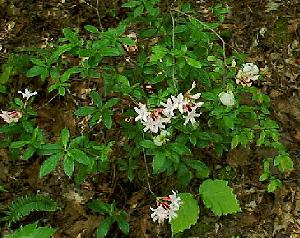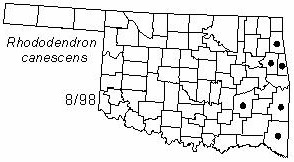
Shrub to 2.4 m (8 ft) in height. Crown open. Twigs brown to mottled gray, densely pubescent with tiny stalked glands when young, becoming glabrous with age. Leaves alternate, simple, leaves rotate terminally; oblong, oblanceolate, or elliptic, 4-10 cm (1.5-4 in) long, 2-3.2 cm (0.8-1.2 in) wide; firm and thick, puberulent with scattered glandular hairs above; canescent beneath, dark green above; cuneate at base, acute, glandular-apiculate at apex, margins with small glandular teeth. Flowers whorled clusters, pedicels 0.8-3 cm (0.3-1.2 in) long and finely glandular-hairy, several flowers, 2.5-5 cm (1-2 inches) long; calyx lobes ovate, detoid or rounded; corolla long and tubular, flaring into 5 lobes, pink; stamens 5, 2.5-3 cm (1-1.2 in) long; flowers appear from March to April, before or with leaves. Fruits capsules, about 2 cm (0.8 in) long, ellipsoid-cylindric.
Distribution: Oklahoma and east Texas, east to Florida and north to Tennessee. Uncommon, restricted to eastern Oklahoma.
Habitat: streamsides in sandy, acid soils.
NWI status: FACW-,FACW
Comments: Rhododendron means rose tree; canescens refers to the white hairs.
Field identification: there are two species of Rhododendron in eastern Oklahoma. Wild honeysuckle has canescent-pilose twigs, unlike Texas azalea (Rhododendron oblongifolium) which has glabrous twigs.
Horticulture: Wild honeysuckle can be propagated by soft root cuttings.
Wildlife benefits: Rhododendron species are a nectar source for hummingbirds.
Food use: wild honeysuckle occassionally produces translucent galls caused by bacteria. These galls are edible and were often pickled by settlers.
Distribution in Oklahoma: 
BACK
NEXT
RETURN TO INDEX
Last update: 9/17/99
 Go to Oklahoma Biological Survey Home Page
Go to Oklahoma Biological Survey Home Page
 Disclaimer
Disclaimer